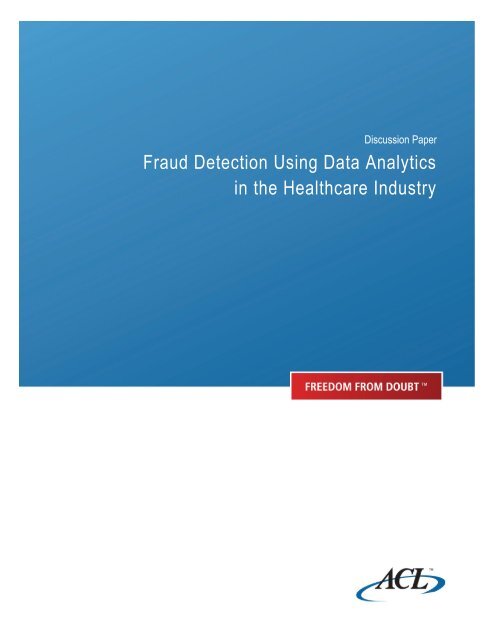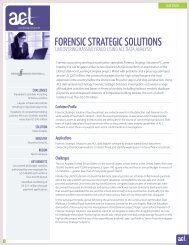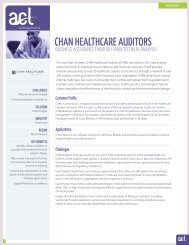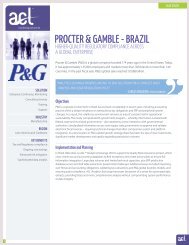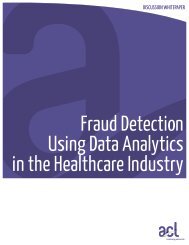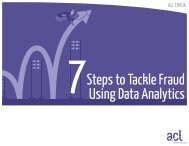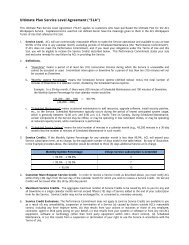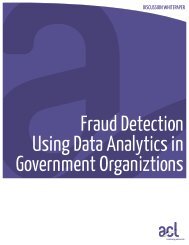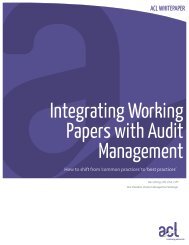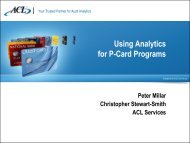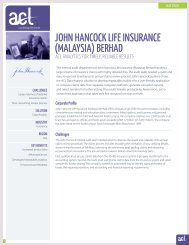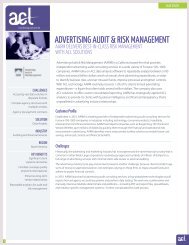Fraud Detection Using Data Analytics in the Healthcare ... - Acl.com
Fraud Detection Using Data Analytics in the Healthcare ... - Acl.com
Fraud Detection Using Data Analytics in the Healthcare ... - Acl.com
- No tags were found...
You also want an ePaper? Increase the reach of your titles
YUMPU automatically turns print PDFs into web optimized ePapers that Google loves.
Discussion Paper<strong>Fraud</strong> <strong>Detection</strong> <strong>Us<strong>in</strong>g</strong> <strong>Data</strong> <strong>Analytics</strong><strong>in</strong> <strong>the</strong> <strong>Healthcare</strong> Industry
<strong>Fraud</strong> <strong>Detection</strong> <strong>Us<strong>in</strong>g</strong> <strong>Data</strong> <strong>Analytics</strong> <strong>in</strong> <strong>the</strong> <strong>Healthcare</strong> Industry 2Why Use <strong>Data</strong> Analysis for <strong>Fraud</strong> <strong>Detection</strong>?<strong>Data</strong> analysis technology enables auditors and fraud exam<strong>in</strong>ers to analyze anorganization’s bus<strong>in</strong>ess data to ga<strong>in</strong> <strong>in</strong>sight <strong>in</strong>to how well <strong>in</strong>ternal controls are operat<strong>in</strong>gand to identify transactions that <strong>in</strong>dicate fraudulent activity or <strong>the</strong> heightened risk of fraud.<strong>Data</strong> analysis can be applied to just about anywhere <strong>in</strong> an organization where electronictransactions are recorded and stored.<strong>Data</strong> analysis also provides an effective way to be more proactive <strong>in</strong> <strong>the</strong> fight aga<strong>in</strong>stfraud. Whistleblower hotl<strong>in</strong>es provide <strong>the</strong> means for people to report suspected fraudulentbehavior but hotl<strong>in</strong>es alone are not enough. Why be only reactive and wait for awhistleblower to f<strong>in</strong>ally <strong>com</strong>e forward? Why not seek out <strong>in</strong>dicators of fraud <strong>in</strong> <strong>the</strong> data?That way, organizations can detect <strong>in</strong>dicators of fraudulent activity much sooner and stop itbefore it be<strong>com</strong>es material and creates f<strong>in</strong>ancial damage.The National Health CareAnti-<strong>Fraud</strong> Association(NHCAA) estimatesconservatively that 3% ofall health care spend<strong>in</strong>g—or $68 billion—is lost tohealth care fraud.www.nhcaa.orgTo effectively test for fraud, all relevant transactions must be tested across all applicable bus<strong>in</strong>ess systems and applications.Analyz<strong>in</strong>g bus<strong>in</strong>ess transactions at <strong>the</strong> source level helps auditors provide better <strong>in</strong>sight and a more <strong>com</strong>plete view as to <strong>the</strong>likelihood of fraud occurr<strong>in</strong>g. It helps focus <strong>in</strong>vestigative action to those transactions that are suspicious or illustrate controlweaknesses that could be exploited by fraudsters. Follow-on tests should be performed to fur<strong>the</strong>r that auditor’s understand<strong>in</strong>g of<strong>the</strong> data and to search for symptoms of fraud <strong>in</strong> <strong>the</strong> data. 1There is a spectrum of analysis that can be deployed to detect fraud. It ranges from po<strong>in</strong>t-<strong>in</strong>-time analysis conducted <strong>in</strong> an adhoc context for one-off fraud <strong>in</strong>vestigation or exploration, through to repetitive analysis of bus<strong>in</strong>ess processes where fraudulentactivity is likely to more likely to occur. Ultimately, where <strong>the</strong> risk of fraud is high and <strong>the</strong> likelihood is as well, organizations canemploy an “always on” or cont<strong>in</strong>uous approach to fraud detection – especially <strong>in</strong> those areas where preventative controls are notpossible or effective.Once an organization gets started with data analysis, <strong>the</strong>y usually f<strong>in</strong>d that <strong>the</strong>y want to do more and dig deeper <strong>in</strong>to <strong>the</strong> data.Modern organizations have <strong>in</strong>creased management demands for <strong>in</strong>formation and <strong>the</strong> audit paradigm is shift<strong>in</strong>g from <strong>the</strong>traditional cyclical approach to a cont<strong>in</strong>uous and risk-based model. Technology <strong>the</strong>refore offers a range of solutions, vary<strong>in</strong>g by<strong>the</strong> size and sophistication of <strong>the</strong> audit organization. From ad hoc analysis, through to repeatable automated procedures, andcont<strong>in</strong>uous audit<strong>in</strong>g and monitor<strong>in</strong>g, analytics provide <strong>in</strong>sight <strong>in</strong>to <strong>the</strong> <strong>in</strong>tegrity of f<strong>in</strong>ancial and bus<strong>in</strong>ess operations throughtransactional analysis. Technology provides more accurate audit reports and better <strong>in</strong>sight <strong>in</strong>to <strong>the</strong> <strong>in</strong>ternal controls framework,and improves <strong>the</strong> ability to access and manage bus<strong>in</strong>ess risk.1Coderre, David G., <strong>Fraud</strong> Analysis Techniques <strong>Us<strong>in</strong>g</strong> ACL, John Wiley & Sons, 2009.
<strong>Fraud</strong> <strong>Detection</strong> <strong>Us<strong>in</strong>g</strong> <strong>Data</strong> <strong>Analytics</strong> <strong>in</strong> <strong>the</strong> <strong>Healthcare</strong> Industry 3Analytical Techniques for <strong>Fraud</strong> <strong>Detection</strong>Gett<strong>in</strong>g started requires an understand<strong>in</strong>g of: The areas <strong>in</strong> which fraud can occur What fraudulent activity would look like <strong>in</strong> <strong>the</strong> data What data sources are required to test for <strong>in</strong>dicators of fraudThe follow<strong>in</strong>g techniques are effective <strong>in</strong> detect<strong>in</strong>g fraud. Auditors should ensure <strong>the</strong>y use <strong>the</strong>se, where appropriate. They<strong>in</strong>clude <strong>the</strong> follow<strong>in</strong>g:• Calculation of statistical parameters (e.g., averages, standard deviations, high/low values) – to identify outliers that could<strong>in</strong>dicate fraud.• Classification – to f<strong>in</strong>d patterns amongst data elements.• Stratification of numbers – to identify unusual (i.e., excessively high or low) entries.• Digital analysis us<strong>in</strong>g Benford’s Law – to identify unexpected occurrences of digits <strong>in</strong> naturally occurr<strong>in</strong>g data sets.• Jo<strong>in</strong><strong>in</strong>g different diverse sources – to identify match<strong>in</strong>g values (such as names, addresses, and account numbers) where<strong>the</strong>y shouldn’t exist.• Duplicate test<strong>in</strong>g – to identify duplicate transactions such as payments, claims, or expense report items.• Gap test<strong>in</strong>g – to identify miss<strong>in</strong>g values <strong>in</strong> sequential data where <strong>the</strong>re should be none.• Summ<strong>in</strong>g of numeric values – to identify control totals that may have been falsified.• Validat<strong>in</strong>g entry dates – to identify suspicious or <strong>in</strong>appropriate times for post<strong>in</strong>gs or data entry. 2Please note that random sampl<strong>in</strong>g is not listed as an effective fraud detection technique. While sampl<strong>in</strong>g is an effective dataanalysis technique for analyz<strong>in</strong>g data values that are consistent throughout <strong>the</strong> data population, <strong>the</strong> very nature of fraud isdifferent as it tends not to occur randomly.2Global Technology Audit Guide: <strong>Fraud</strong> Prevention and <strong>Detection</strong> <strong>in</strong> an Automated World. The Institute of Internal Auditors, 2009.
<strong>Fraud</strong> <strong>Detection</strong> <strong>Us<strong>in</strong>g</strong> <strong>Data</strong> <strong>Analytics</strong> <strong>in</strong> <strong>the</strong> <strong>Healthcare</strong> Industry 4<strong>Fraud</strong> <strong>Detection</strong> Program StrategiesInstead of rely<strong>in</strong>g on reactive measures like whistleblowers, organizations can andshould take a more hands-on approach to fraud detection. A fraud detection andprevention program should <strong>in</strong>clude a range of approaches – from po<strong>in</strong>t-<strong>in</strong>-time torecurr<strong>in</strong>g and, ultimately, cont<strong>in</strong>ually for those areas where <strong>the</strong> risk of fraud warrants.Based on key risk <strong>in</strong>dicators, po<strong>in</strong>t-<strong>in</strong>-time (or ad hoc) test<strong>in</strong>g will help identifytransactions to be <strong>in</strong>vestigated. If that test<strong>in</strong>g reveals <strong>in</strong>dicators of fraud, recurr<strong>in</strong>gtest<strong>in</strong>g or cont<strong>in</strong>uous analysis should be considered.A KPMG Forensics’ <strong>Fraud</strong> Risk Management report states, “unlike retrospectiveanalyses, cont<strong>in</strong>uous transaction monitor<strong>in</strong>g allows an organization to identifypotentially fraudulent transactions on, for example, a daily, weekly, or monthly basis.Organizations frequently use cont<strong>in</strong>uous monitor<strong>in</strong>g efforts to focus on narrow bands oftransactions or areas that pose particularly strong risks.” 3By leverag<strong>in</strong>g <strong>the</strong> power of data analysis technology organizations can detect fraudsooner and reduce <strong>the</strong> negative impact of significant losses ow<strong>in</strong>g to fraud.“ACL AuditExchangeleverages ACL's provenanalytical strengths andInformatica's data<strong>in</strong>tegration capabilities toprovide auditors with ameans to perform dataanalyses and helpeffectively detect andprevent fraud."David Coderrelead<strong>in</strong>g author of books such as “Computer-Aided<strong>Fraud</strong> <strong>Detection</strong> & Prevention: A Step-by-Step Guide”Time and attendance analysis uncovers fraudPenny Borjas CFE, CIA, B.A, Certified <strong>Fraud</strong> Exam<strong>in</strong>er and Internal Auditor“When I was work<strong>in</strong>g <strong>in</strong> <strong>the</strong> health care <strong>in</strong>dustry, we developed a technology-based project to monitor staff time and attendancedata. Health care professionals (such as physicians, nurses and specialists) are paid <strong>in</strong> different ways, depend<strong>in</strong>g on <strong>the</strong> natureof <strong>the</strong>ir positions, <strong>the</strong> work, and <strong>the</strong> facility. All <strong>the</strong> pay rates have unique electronic codes, so my team began by pull<strong>in</strong>g <strong>the</strong>code for staff members work<strong>in</strong>g on-call. We looked at typical on-call data and learned what would <strong>com</strong>prise accurate cod<strong>in</strong>g.We <strong>the</strong>n set up constra<strong>in</strong>ts and exception conditions, such as a maximum number of consecutive hours spent on-call. We usedaudit analytics to pull <strong>the</strong> files and quickly ran <strong>the</strong> data through our script.Immediately, we found staff members who had supposedly worked on-call 24 hours a day, seven days a week (an impossibility)or were paid for on-call time while <strong>the</strong>y were away on vacation. It was an extremely fast, straightforward data analysis projectthat quickly highlighted potential time and attendance fraud.”3“<strong>Fraud</strong> Risk Management: Develop<strong>in</strong>g a Strategy for Prevention, <strong>Detection</strong> and Response.” KPMG International, 2006
<strong>Fraud</strong> <strong>Detection</strong> <strong>Us<strong>in</strong>g</strong> <strong>Data</strong> <strong>Analytics</strong> <strong>in</strong> <strong>the</strong> <strong>Healthcare</strong> Industry 5<strong>Healthcare</strong><strong>Healthcare</strong> fraud is a serious f<strong>in</strong>ancial dra<strong>in</strong> on <strong>the</strong> health care systems <strong>in</strong>many jurisdictions. It represents a serious dra<strong>in</strong> on <strong>the</strong> effectiveness ofprovid<strong>in</strong>g health care to those <strong>in</strong> need.Ow<strong>in</strong>g to <strong>the</strong> large numbers of cases reported, <strong>in</strong>vestigated andprosecuted, it has been identified as a “high-risk” area <strong>in</strong> many regions.<strong>Healthcare</strong> Related <strong>Fraud</strong> SchemesHere are a few typical fraud schemes encountered <strong>in</strong> healthcare and someexamples of <strong>the</strong> way data analysis can be applied to detect and prevent<strong>the</strong>m:<strong>Healthcare</strong> – 107 CasesScheme Number of Cases Percent of CasesCorruption 31 29.0%Skimm<strong>in</strong>g 24 22.4%Bill<strong>in</strong>g 23 21.5%Non-Cash 21 19.6%Check Tamper<strong>in</strong>g 13 12.1%Expense Reimbursements 12 11.2%Payroll 10 9.3%Cash on Hand 9 8.4%Larceny 8 7.5%F<strong>in</strong>ancial Statement <strong>Fraud</strong> 4 3.7%Register Disbursements 1 0.9%• Match OIG-excluded providers list with vendor, employee master files.• F<strong>in</strong>d kickbacks paid <strong>in</strong> exchange for referr<strong>in</strong>g bus<strong>in</strong>ess.• Identify charges posted outside of proper GL period.• Highlight “upcod<strong>in</strong>g” of procedures: Statistically outly<strong>in</strong>g numbers.• Match vendor names/addresses/tax IDs to payroll records for employees.• Summarize large <strong>in</strong>voices without purchase orders, by amount, vendor, etc.Distribution of <strong>Fraud</strong> Schemes <strong>in</strong> <strong>Healthcare</strong> 4• Compare list of valid signed-up employees to list of people actually receiv<strong>in</strong>g health benefits from <strong>in</strong>surance <strong>com</strong>pany.• Highlight bill<strong>in</strong>g for medically unnecessary tests.• Identify false/<strong>in</strong>valid/duplicate Social Security numbers.• Highlight excessive use of high risk DRGs (“Diagnosis-Related Groups”)• Identify excessive bill<strong>in</strong>g by a s<strong>in</strong>gle physician• Identify employee overtime abuses.• Report entries aga<strong>in</strong>st authorization records for new or term<strong>in</strong>ated employees.• Identify multiple payroll deposits to <strong>the</strong> same bank account.42010 Global <strong>Fraud</strong> Study: Report to <strong>the</strong> Nations on Occupational <strong>Fraud</strong> and Abuse, Association of Certified <strong>Fraud</strong> Exam<strong>in</strong>ers
<strong>Fraud</strong> <strong>Detection</strong> <strong>Us<strong>in</strong>g</strong> <strong>Data</strong> <strong>Analytics</strong> <strong>in</strong> <strong>the</strong> <strong>Healthcare</strong> Industry 6O<strong>the</strong>r Resources• Association of Certified <strong>Fraud</strong> Exam<strong>in</strong>ers (ACFE): <strong>the</strong> world's largest anti-fraudorganization and premier provider of anti-fraud tra<strong>in</strong><strong>in</strong>g and education. www.acfe.org• The Institute of Internal Auditors (The IIA): www.<strong>the</strong>iia.org» International Standards for <strong>the</strong> Professional Practice of Internal Audit<strong>in</strong>g (Standards):The Standards are mandatory requirements – pr<strong>in</strong>ciple-focused and provid<strong>in</strong>g aframework for perform<strong>in</strong>g and promot<strong>in</strong>g <strong>in</strong>ternal audit<strong>in</strong>g.» Internal Audit<strong>in</strong>g and <strong>Fraud</strong> Practice Guide: guidance on how to <strong>com</strong>ply with <strong>the</strong>International Standards for <strong>the</strong> Professional Practice of Internal Audit<strong>in</strong>g.To f<strong>in</strong>d out how ACL can helpyour organization <strong>com</strong>bat fraud,contact us at +1-604-669-4225or <strong>in</strong>fo@acl.<strong>com</strong> to arrange fora free consultation.» GTAG 13: <strong>Fraud</strong> Prevention and <strong>Detection</strong> Techniques <strong>in</strong> an Automated World: step-by-step process guide for audit<strong>in</strong>ga fraud prevention program, <strong>in</strong>clud<strong>in</strong>g an explanation of <strong>the</strong> various types of data analysis to use <strong>in</strong> detect<strong>in</strong>g fraud,and a technology fraud risk assessment template.• ACL Detect<strong>in</strong>g <strong>Fraud</strong> resource page: anti-fraud materials <strong>in</strong>clud<strong>in</strong>g <strong>in</strong>dustry reports, case studies and on-demandweb<strong>in</strong>ars. www.acl.<strong>com</strong>/healthcarefraudAbout ACL Services Ltd.ACL Services Ltd. is <strong>the</strong> lead<strong>in</strong>g global provider of bus<strong>in</strong>ess assurance technology for audit and <strong>com</strong>pliance professionals.Comb<strong>in</strong><strong>in</strong>g market-lead<strong>in</strong>g audit analytics software with centralized content management and exception report<strong>in</strong>g, ACLtechnology provides a <strong>com</strong>plete end-to-end bus<strong>in</strong>ess assurance platform that is flexible and scalable to meet <strong>the</strong> needs of anyorganization.© 2010 ACL Services Ltd.DP/HC/200710ACL and <strong>the</strong> ACL logo are trademarks or registeredtrademarks of ACL Services Ltd. All o<strong>the</strong>r trademarksare <strong>the</strong> property of <strong>the</strong>ir respective owners.S<strong>in</strong>ce 1987, ACL technology has helped organizations reduce risk, detect fraud, enhance profitability and improve bus<strong>in</strong>essperformance. ACL delivers its solutions to 14,000 organizations <strong>in</strong> over 150 countries through a global network of ACL officesand channel partners. Our customers <strong>in</strong>clude 95 percent of Fortune 100 <strong>com</strong>panies, 85 percent of <strong>the</strong> Fortune 500 and overtwo-thirds of <strong>the</strong> Global 500, as well as hundreds of national, state and local governments, and <strong>the</strong> Big Four public account<strong>in</strong>gfirms. www.acl.<strong>com</strong>


